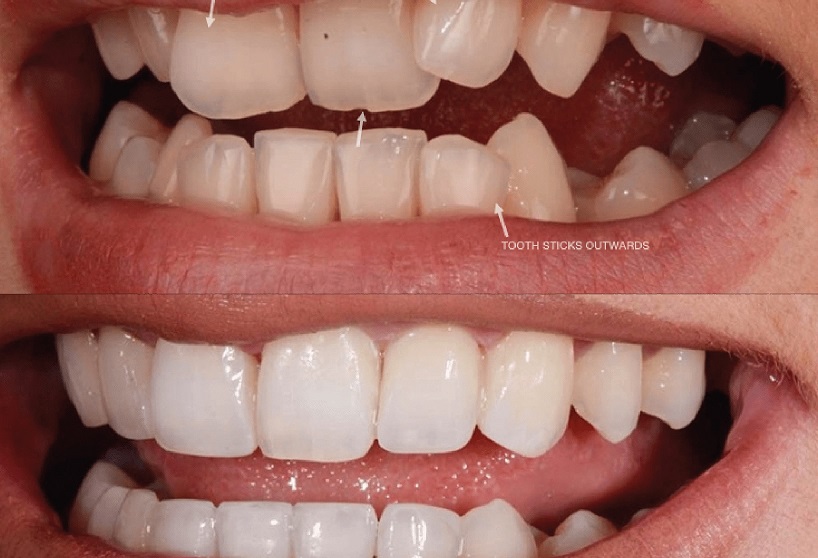
Composite bonding (which is also known as tooth or dental bonding or composite veneering) is a procedure that is used as a solution for minor tooth defects and for correcting spacing in teeth.
It involves using composite resin which is a white filling material to completely cover or add to teeth to improve a smile. The color of the resin is matched to your teeth, so it will appear as though it is a natural part of the tooth. It can be used in place of veneers so that similar smile results can be gotten with less stress than other procedures such as say, dental veneers.
Composite bonding is an easy procedure that can be performed within only one day by a cosmetic dentist, causing it to be popularly referred to as a ‘same-day orthodontist’ job. It can be used to correct the following smile problems:
● Repairing tooth decay.
● Repairing chipped, cracked, or fractured teeth.
● Correcting discolored teeth.
● Closing gaps between teeth.
● Reshaping oddly-shaped teeth.
● Protection of any exposed roots.
PROCEDURE FOR COMPOSITE BONDING
Composite bonding is a simple, non-invasive procedure that usually requires no more than two visits to the cosmetic dentist.
The first visit is the consultation, where the dentist will conduct an oral examination of your mouth. The dentist will determine if you are an ideal candidate for the procedure and will listen to any requests you have before giving suggestions. Once the dentist knows exactly what he’s going to do, a second appointment will be scheduled where the actual procedure will be carried out.
The procedure usually begins with the dentist cleaning your teeth thoroughly in preparation for the application of the resin. A very thin layer of enamel might have to be removed in severe cases, however, teeth don’t need to be cut if only minor shape and color changes are needed.
Before the material is added, your teeth will be lightly etched (that is roughened) to aid the adhesion.
After that, adhesive glue will be added to your teeth to help the composite resin material stick to your teeth. Finally, very thin layers of the composite resin are added to the tooth surface while being molded into the ideal shape.
The cosmetic dentist will then cure (i.e quickly harden) the layers of the resin with a special high-intensity light. If needed, you will receive further trimming and shaping to perfect the appearance. After one last polish, the work is done.
You should select a shade of white that is just right for you so the teeth look natural.
BENEFITS OF COMPOSITE BONDING
● QUICK: Composite bonding is a quick, easy procedure that can be completed with at most two visits to the dentist. It’s a very fast and efficient way of dealing with minor smile defects.
● NONINVASIVE: Bonding is also noninvasive. Other procedures like crowns and veneers involve the removal of the outer surface of the tooth permanently. The dentist only needs to roughen the tooth surface to aid the bonding process, which means no part of the tooth structure is lost. Only in extreme cases will the enamel need to be removed, and even then only lightly. Composite bonding improves the smile without causing additional damage to the teeth.
● CHEAPER: Composite bonding is also notably cheaper than other procedures like crowns and veneers. Since it does not normally require a dental ceramic technician to construct the veneer and therefore saves both the patient and dentist, time and money. Composite veneers are usually about 50% less in investment cost compared to porcelain veneers.
● NATURAL-LOOKING: The ability of composite resins to mimic natural shiny tooth enamel has improved greatly over the past few years. The materials can in some cases look as good, and sometimes better than other procedures like porcelain veneers.
LIMITS OF COMPOSITE BONDING
While composite bonding is an amazing method of treating defects, it has a few limits.
● It stains over time.
● It is less biologically compatible with the gums, therefore it tends to collect bacteria and causes inflammation of the gums much more readily than porcelain veneers.
● It is porous (i.e it has tiny holes and voids in its surface).
● It is only a temporary solution and can only last for about two to three (2-3) years before it needs to be replaced.
CARE OF COMPOSITE BONDS
Composite bonds are easy to maintain. Here are a few things you should do to get the most out of your composite veneers.
● Brush twice daily and flossing should at least once a day. The dentist will recommend getting a soft-bristled brush and nonabrasive toothpaste to protect the restoration.
● Reduce intake of colored drinks. Teeth-staining drinks like red wine, tea, and coffee can discolor both the composite and natural teeth.
● Consume a healthy diet. Patients need to eat healthily to provide their bodies with the nutrients required to keep their teeth strong.


Comments are closed.